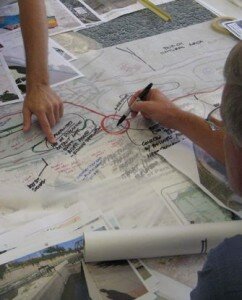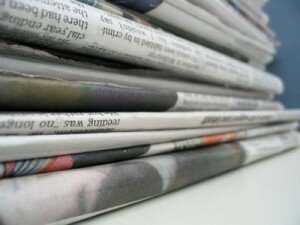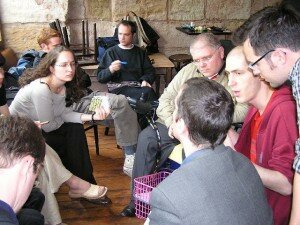 Sometimes it’s hard to find a way to get kids involved in volunteering. Planning your own service projects with your children might be the easiest way to introduce them to ways that they can make a difference in their community.
Sometimes it’s hard to find a way to get kids involved in volunteering. Planning your own service projects with your children might be the easiest way to introduce them to ways that they can make a difference in their community.
Planning your own small projects are a great way to make time to spend together as a family. Smaller projects are a great way to make sure your kids can take the time to talk about the kind of volunteering they’re doing and the impact that they’re having.
-
 Holiday Cooking Party – Hold a holiday cooking party with friends and family making bread, soups, and even some cookies for a food pantry or shelter. Guests can cook or bake together, or make healthy bags of snacks. It’s a great way to bring family and friends together to help out during the holidays!
Holiday Cooking Party – Hold a holiday cooking party with friends and family making bread, soups, and even some cookies for a food pantry or shelter. Guests can cook or bake together, or make healthy bags of snacks. It’s a great way to bring family and friends together to help out during the holidays! - Put together hygiene kits to pass out to the local homeless shelters. – You can request donation in your community of mini soaps and shampoos and other things like hand sanitizer and tissues.
- Consider donating your family’s old coats for warmth this winter. – As fast as kids grow, you might buy a new coat every year or two. Search One Warm Coat to find a coat drive in your area. You can even get them to help you organize your own coat drive in your school or neighborhood!
-
 Hold a stuffed animals drive.- Donate the gifts to your local police department. Patrol officers can keep them in their trunk to give to kids who are traumatized by a car accident, abuse, or other incident.
Hold a stuffed animals drive.- Donate the gifts to your local police department. Patrol officers can keep them in their trunk to give to kids who are traumatized by a car accident, abuse, or other incident. - Help out at a kid’s holiday party. – Many community associations or non-profit organizations put on holiday events for children. They often need volunteers to help with games, crafts, and more.
-
 Share the joy of reading with another child. – Have your children’s favorite books have changed over time? Talk to them about donating older books to a local school, Head Start program, or shelter that houses families.
Share the joy of reading with another child. – Have your children’s favorite books have changed over time? Talk to them about donating older books to a local school, Head Start program, or shelter that houses families. - Offer your services at a women’s shelter. – From anything to helping wrap gifts for children to offering child care services, women in these shelters are usually working on trying to better themselves for their family.

 Honorees included Nicole Muller, founder of Neighbors-4-Neighbors. Nicole started an annual food drive called Neighbors-4-Neighbors. On Make A Difference Day 2009, she collected and donated 2.5 tons of food to the Blue Ridge Area Food Bank. But the 17-year-old honor student knew she could do even better.
Honorees included Nicole Muller, founder of Neighbors-4-Neighbors. Nicole started an annual food drive called Neighbors-4-Neighbors. On Make A Difference Day 2009, she collected and donated 2.5 tons of food to the Blue Ridge Area Food Bank. But the 17-year-old honor student knew she could do even better. Addie and Delaney Kenney, started an “almost sleepover.” Participants must like hanging out in pajamas, dancing, eating ice cream and helping kids in need. Somehow, they had no trouble recruiting 36 girls to attend their movement’s signature event; admission price: a new pair of PJs for kids at a shelter. The guests made treats for seniors, crafted holiday decorations for hospital patients and collected $80 for charity.
Addie and Delaney Kenney, started an “almost sleepover.” Participants must like hanging out in pajamas, dancing, eating ice cream and helping kids in need. Somehow, they had no trouble recruiting 36 girls to attend their movement’s signature event; admission price: a new pair of PJs for kids at a shelter. The guests made treats for seniors, crafted holiday decorations for hospital patients and collected $80 for charity. Nicholas Cobb collects money to buy coats for kids at a local shelter for abused children. In 2009, he raised $3,400 to buy coats. In 2010, he raised $4,500. Nicholas’ nonprofit, Comfort and Joy, raises money to help the homeless each Make A Difference Day.
Nicholas Cobb collects money to buy coats for kids at a local shelter for abused children. In 2009, he raised $3,400 to buy coats. In 2010, he raised $4,500. Nicholas’ nonprofit, Comfort and Joy, raises money to help the homeless each Make A Difference Day. Today’s post comes from Laura Rog, Director of Training and Technical Assistance with
Today’s post comes from Laura Rog, Director of Training and Technical Assistance with  Obviously, we all want our service projects to be nice. We want youth to have fun and be excited about what they do.
Obviously, we all want our service projects to be nice. We want youth to have fun and be excited about what they do. Today’s post comes from Marilyn Price-Mitchell, PhD, a developmental psychologist, educator, researcher, writer and speaker who is passionate about helping young people and organizations achieve their highest potential and maximize outcomes for the public good.
Today’s post comes from Marilyn Price-Mitchell, PhD, a developmental psychologist, educator, researcher, writer and speaker who is passionate about helping young people and organizations achieve their highest potential and maximize outcomes for the public good. Developing compassion in elementary and middle school-aged children is akin to developing muscle strength. The more you use your muscles, the stronger they get.
Developing compassion in elementary and middle school-aged children is akin to developing muscle strength. The more you use your muscles, the stronger they get. Compassion causes us to remain charitable, even if others behave negatively. Research shows that compassion plays a key role in helping children develop into engaged, caring, and optimistic adults.
Compassion causes us to remain charitable, even if others behave negatively. Research shows that compassion plays a key role in helping children develop into engaged, caring, and optimistic adults.
 Developing compassion in children involves all adults stepping up to do their parts – families, teachers, clergy, and community leaders. But we know from research that one of the most important places that compassion is learned is in the home.
Developing compassion in children involves all adults stepping up to do their parts – families, teachers, clergy, and community leaders. But we know from research that one of the most important places that compassion is learned is in the home. Compassion cannot be learned by talking about it. Children must practice compassion in their daily lives. Difficult encounters with family members, classmates, and friends present opportunities for kids to put themselves in another’s shoes – to practice empathy.
Compassion cannot be learned by talking about it. Children must practice compassion in their daily lives. Difficult encounters with family members, classmates, and friends present opportunities for kids to put themselves in another’s shoes – to practice empathy. Anger is one of the greatest hindrances to compassion because it can overwhelm children’s minds and spirit. Yet there are times when anger yields energy and determination.
Anger is one of the greatest hindrances to compassion because it can overwhelm children’s minds and spirit. Yet there are times when anger yields energy and determination. Always encourage elementary and middle school children to talk about their anger with a supportive adult. Teaching compassion doesn’t mean turning a blind eye to aggression in others. We all know that children get bullied and are often not treated fairly by peers. If remaining calm only encourages more aggression, then we must also help children take a strong stand without retaliatory anger.
Always encourage elementary and middle school children to talk about their anger with a supportive adult. Teaching compassion doesn’t mean turning a blind eye to aggression in others. We all know that children get bullied and are often not treated fairly by peers. If remaining calm only encourages more aggression, then we must also help children take a strong stand without retaliatory anger. Celebrated annually during the third week of October, Make Your Mark Week (formerly Kids Care Week) inspires and mobilizes youth to use their energy, ingenuity and compassion to “make their mark on the world” through hands-on service.
Celebrated annually during the third week of October, Make Your Mark Week (formerly Kids Care Week) inspires and mobilizes youth to use their energy, ingenuity and compassion to “make their mark on the world” through hands-on service. We, of course, continue to offer our tried and true methods of issue-based education including: compassion education stories for young children and fact sheets for kids and teens. This year, they are updated and newly named:
We, of course, continue to offer our tried and true methods of issue-based education including: compassion education stories for young children and fact sheets for kids and teens. This year, they are updated and newly named:  Establishing goals at the onset of your group project, allows for you to measure the outcomes of your project. Consider these questions: Is there a current event that has emotionally affected you or might have emotionally affected others around you? What change would you like to see in your community?
Establishing goals at the onset of your group project, allows for you to measure the outcomes of your project. Consider these questions: Is there a current event that has emotionally affected you or might have emotionally affected others around you? What change would you like to see in your community? Find volunteers or contact other local nonprofits that can help provide volunteers. If your project is important to the community, you will find many people eager to be involved. Place flyers at your local post office, park, grocery store, school, community bulletin boards. Volunteer recruitment will also help make people aware of your group project. Social media outlets will also help with volunteer recruitment. Websites such as , , , and a personal blog can easily reach a wide range of people.
Find volunteers or contact other local nonprofits that can help provide volunteers. If your project is important to the community, you will find many people eager to be involved. Place flyers at your local post office, park, grocery store, school, community bulletin boards. Volunteer recruitment will also help make people aware of your group project. Social media outlets will also help with volunteer recruitment. Websites such as , , , and a personal blog can easily reach a wide range of people. Remember to thank your volunteers! Thank your volunteers so that they can feel appreciated and want to volunteer for future projects. Whether it’s a hand-written note filled with a simple message and encouraging words or talking to your volunteers individually-thank them! If you’re not quite sure how, we have
Remember to thank your volunteers! Thank your volunteers so that they can feel appreciated and want to volunteer for future projects. Whether it’s a hand-written note filled with a simple message and encouraging words or talking to your volunteers individually-thank them! If you’re not quite sure how, we have 
 Family volunteering enables populations whose volunteering has been restrained by family care-giving obligations (either responsibilities to children or seniors) to become involved. As a “two for one” activity, family volunteering greatly increases the ability of time-depleted working families to engage in service. It is a true “minimum time, maximum benefit” system.
Family volunteering enables populations whose volunteering has been restrained by family care-giving obligations (either responsibilities to children or seniors) to become involved. As a “two for one” activity, family volunteering greatly increases the ability of time-depleted working families to engage in service. It is a true “minimum time, maximum benefit” system.
 Call an easily accessible town meeting of community members and project team members. Brainstorm challenges facing the community and select one as the top priority.
Call an easily accessible town meeting of community members and project team members. Brainstorm challenges facing the community and select one as the top priority.
 Contact the government or public policy program at a local university or college. Ask students to survey the local residents about their concerns.
Contact the government or public policy program at a local university or college. Ask students to survey the local residents about their concerns.


 Walk, ride your bike, carpool or take public transportation
Walk, ride your bike, carpool or take public transportation Sort clothes at a social service agency
Sort clothes at a social service agency



 When volunteers take a few moments at the end of a project to reflect on the work that they’ve done, it helps to turn a volunteer experience into a learning opportunity. Reflection gives volunteers the time and space to examine their service, interpret their feelings and aply their experience to broader community issues. Reflection helps volunteers to grow because they are making themselves aware of the impact they are having and allowing themselves to see the changes that they have made with their service.
When volunteers take a few moments at the end of a project to reflect on the work that they’ve done, it helps to turn a volunteer experience into a learning opportunity. Reflection gives volunteers the time and space to examine their service, interpret their feelings and aply their experience to broader community issues. Reflection helps volunteers to grow because they are making themselves aware of the impact they are having and allowing themselves to see the changes that they have made with their service.

